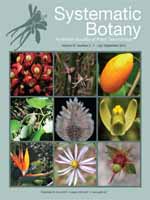Vriesea is the second-largest genus of Bromeliaceae, with more than 280 species. Although the genus is traditionally circumscribed as a natural group, all phylogenetic analysis undertaken indicates its polyphyletic origin. Several groups of Vriesea species are difficult to define taxonomically based on morphological characters only, including the Vriesea corcovadensis group, composed of 11 species. We evaluated the monophyly and relationships among the species of the V. corcovadensis group through a maximum parsimony morphological analysis. The data set contains information about all 11 species placed in this group; in addition, species from six related genera of Tillandsioideae were included, for a total of 23 terminal taxa. Two separate analyses were carried out, the first containing 54 characters (42 from external morphology and 12 from leaf anatomy), and the second containing only characters from external morphology. The purpose of this distinction was to evaluate the phylogenetic signal of the anatomical characters. The first analysis with 54 characters produced two most-parsimonious trees with 239 steps, CI = 0.40 and RI = 0.54. The second analysis with 42 characters generated six trees with 187 steps, CI = 0.39 and RI = 0.52. The prior separation of the V. corcovadensis group was not supported in either analysis, confirming the difficulty of circumscribing monophyletic groups in the genus. Use of the anatomical characters helped to produce a tree with higher resolution. The leaf anatomy of the group is described for the first time. We report anatomical features among the different species of the V. corcovadensis group, thus corroborating the analysis based on characteristics of external morphology for these species. All of these features are apparently plesiomorphic, since the group was shown to be paraphyletic. However, only through a comprehensive analysis of Tillandsioideae as whole will it become possible to identify monophyletic groups in Vriesea with some accuracy.
How to translate text using browser tools
1 July 2012
A Morphological Cladistic Analysis of the Vriesea corcovadensis Group (Bromeliaceae: Tillandsiodeae), with Anatomical Descriptions: New Evidence of the Non-Monophyly of the Genus
Janaína Gomes-da-Silva,
Flavia Alves da Costa Vargens,
Rosani do Carmo de Oliveira Arruda,
Andrea Ferreira da Costa
ACCESS THE FULL ARTICLE

Systematic Botany
Vol. 37 • No. 3
July 2012
Vol. 37 • No. 3
July 2012
Anatomical characters
bromeliad
lamina
morphology
phylogeny
Tillandsia




